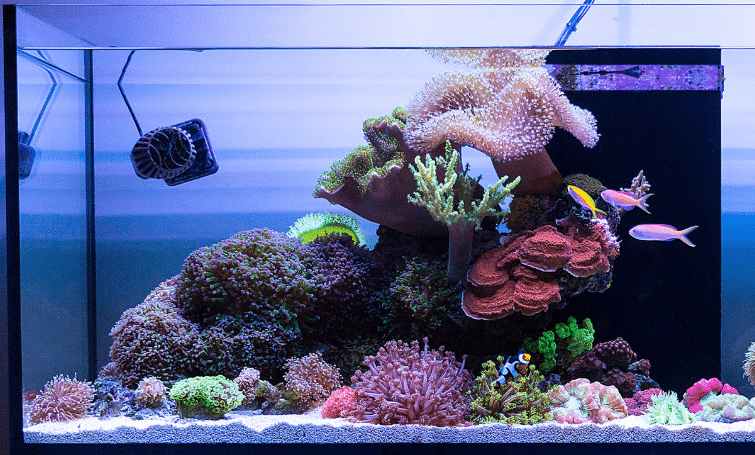Maintaining a clean saltwater aquarium is essential for the health of your marine life. Unlike freshwater tanks, saltwater aquariums require extra care to manage water quality, prevent algae growth, and maintain stable conditions for fish, corals, and invertebrates. In this guide, we’ll cover the best practices for cleaning a saltwater aquarium, ensuring a balanced and thriving marine environment.
Why Regular Cleaning Is Crucial for Saltwater Aquariums
Saltwater tanks are more delicate than freshwater tanks, and poor maintenance can lead to:
- Algae Overgrowth: Excess nutrients can trigger unwanted algae.
- Water Quality Issues: Ammonia, nitrites, and nitrates can harm marine life.
- Coral and Fish Stress: Dirty tanks create unstable conditions that stress fish and corals.
Regular cleaning not only keeps the tank looking beautiful but also helps maintain a stable marine ecosystem.

Daily Saltwater Aquarium Maintenance
1. Check Water Parameters
- Use a saltwater test kit to monitor ammonia, nitrites, nitrates, and pH.
- Ensure salinity remains between 1.023-1.026 SG.
- Keep temperature stable at 76-82°F for fish and coral health.
2. Remove Uneaten Food
- Overfeeding can lead to ammonia spikes. Use a gravel vacuum or siphon to remove food debris.
- Feed small portions to prevent excess waste.
3. Inspect Fish and Corals
- Look for signs of disease, stress, or aggression.
- Check corals for discoloration or tissue damage.
Weekly Saltwater Aquarium Cleaning Routine
1. Perform a Partial Water Change
- Change 10-15% of the water weekly to remove excess nutrients.
- Use pre-mixed saltwater with the same salinity and temperature as the tank.
2. Clean the Glass and Remove Algae
- Use a magnetic algae scraper to clean the tank walls.
- For stubborn algae, try a soft sponge or acrylic-safe scraper.
3. Rinse and Clean Equipment
- Remove and clean protein skimmers and filter socks to maintain efficiency.
- Rinse powerheads and wave makers to prevent buildup.
For more in-depth cleaning tips, visit Aquarium Glass Cleaning Without Harming Your Fish.
Monthly Saltwater Aquarium Deep Cleaning
1. Deep Clean Substrate
- Use a gravel vacuum to remove detritus from sand beds.
- Avoid disturbing deep sand beds, as they help with nitrate reduction.
2. Inspect and Replace Filter Media
- Replace carbon filters and phosphate removers as needed.
- Clean biological filter media in tank water to preserve beneficial bacteria.
3. Scrub Rocks and Decorations
- Remove excessive algae growth from live rock with a soft brush.
- Avoid using soap or chemicals, as they can harm marine life.
Preventing Algae and Maintaining a Balanced Aquarium
1. Control Nutrient Levels
- Keep nitrates below 10 ppm and phosphates below 0.05 ppm.
- Use protein skimmers and macroalgae (like Chaetomorpha) to absorb excess nutrients.
2. Regulate Lighting
- Limit light exposure to 8-10 hours per day to prevent algae overgrowth.
- Use a timer for consistent light cycles.
3. Introduce Algae-Eating Clean-Up Crew
- Snails (Nassarius, Trochus, or Cerith)
- Hermit Crabs
- Blennies or Tang Fish for larger tanks
For more maintenance strategies, see Aquarium Overhaul: A Complete Guideline.
Conclusion
Keeping a saltwater aquarium clean requires consistent care and attention to detail. By following these best practices—such as regular water changes, algae control, and equipment maintenance—you can create a thriving marine environment. With the right cleaning routine, your saltwater tank will remain healthy, balanced, and visually stunning.
FAQs
1. How often should I change the water in a saltwater aquarium?
Perform a 10-15% water change weekly to maintain stable water conditions.
2. Can I clean my saltwater tank with tap water?
No, always use RO/DI water to avoid harmful chemicals and minerals.
3. How do I remove salt creep from my aquarium?
Wipe down surfaces with a damp cloth, and prevent excess evaporation.
4. What is the best way to clean live rock?
Use a soft brush and saltwater to scrub off algae without killing beneficial bacteria.
5. Should I vacuum the sand in my saltwater tank?
Yes, but only the surface layer to avoid disturbing beneficial bacteria in deep sand beds.
Pingback: Aquarium Lighting: Maintenance Tips and Tricks - indooraqua
Pingback: How Water Movement Contributes to Aquarium Fish Health - indooraqua
Pingback: The Importance of Regular Water Testing - indooraqua